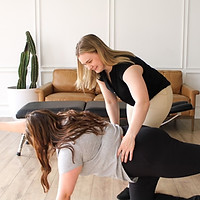Chiropractor & Physical Therapy for Spondylolysis Treatment in Carrollton, TX
Spondylolysis is a stress injury or small fracture in a thin part of a vertebra called the pars, which helps connect the joints of the spine. It usually happens in the lower back but can also occur in the neck.
You may hear it called a “pars defect” or “pars fracture.” It’s especially common in athletes like gymnasts, football players, cheerleaders, and dancers, anyone who repeatedly bends their back backward. Over time, that repetitive movement can weaken the bone, causing it to crack. If the bone doesn’t heal properly, it can progress into a stress fracture and may eventually lead to spondylolisthesis, where the vertebra starts to slip forward.
Key Points About Spondylolysis:
Common in younger individuals: Spondylolysis is often seen in athletes, especially those involved in sports that require repetitive hyperextension of the spine (like gymnastics, football, cheerleading, dancing or weightlifting).
Symptoms: Many people with spondylolysis may not experience symptoms, but in some cases, it can lead to lower back pain, especially after activity or physical exertion. Pain may be localized to the lower back or spread to the hips or legs.
Causes: The condition can be caused by repetitive stress or overuse, leading to small fractures in the pars interarticularis. In some cases, it may also be congenital, meaning a person is born with a weakness in this part of the vertebra.
Diagnosis: It is typically diagnosed through imaging studies like X-rays (when it has fractured all the way through), MRI, or CT scans. In some cases, a single photon emission computed tomography (SPECT) scan may be used to detect the stress fracture.
Symptoms of Low Back Pain:
The symptoms of low back pain can vary depending on the underlying cause. They may include:
Localized pain: Pain directly in the lower back, which can be dull, sharp, or throbbing.
Radiating pain: Pain that extends into the hips, buttocks, or legs (e.g., sciatica). This is common in cases of a herniated disc or spinal stenosis.
Stiffness: Difficulty moving or bending the back due to tight muscles or inflammation.
Numbness or tingling: In some cases, nerve compression can cause numbness or tingling in the legs or feet.
Weakness: Muscle weakness or a feeling of "giving way" in the legs, which can be caused by nerve irritation or compression.
Difficulty standing or sitting for long periods: Prolonged sitting or standing may exacerbate the pain, leading to discomfort or a need to change positions frequently.
What's the difference between Spondylolysis and Spondylolysthesis?
While both are often referred to as "spondy" or "spondy pain", Spondylolysis and Spondylolisthesis are two different spinal conditions, with different treatment programs, as well as different symptoms.
Spondylolysis is a defect or fracture in the vertebral bone without vertebral slippage. The treatment for Spondylolysis can be less aggressive, including rest, chiropractic treatments listed above, and anti-inflammatory medications.
Spondylolisthesis is a slippage of one vertebra over another, which can occur due to Spondylolysis or other causes. Depending on the severity of the slippage, the treatment for Spondylolisthesis tends to be a bit more aggressive, with more rehabilitative exercises, manual therapy, and other chiropractic treatments listed above.
If left untreated, Spondylolysis can sometimes progress to Spondylolisthesis, but not always.
How can Chiropractic Care or Physical Help with Pain Associated with Spondylolysis?
At Elevation, we utilize a wide variety of techniques and treatments to improve symptoms related to Spondylolysis. Depending on the severity and stage of the Spondylosis and location can result in different treatment programs. At Elevation, our goal is to reduce symptoms and pain associated with the stress reaction or stress fracture and then stabilize the muscle tissue around it with strengthening exercises. It's not a one-size fits all situation because each patient with this is treated different and each person may present with unique compensation patterns that amplify symptoms. We utilize different soft tissue treatments such as manual therapy, dry needling, IASTM, cupping, and shockwave therapy. We also use specific spinal manipulation or adjusting that do not threaten the stress reaction or stress fracture to improve range of motion and mobility through the spine effectively. We usually teach a progression of advanced rehabilitation and strengthening exercises for the low back and surrounding regions as well to help ease and reduce symptoms long-term.
Try this Exercise for Spondylolysis Pain
This modified version of a Pallof press is one of our favorite go-to exercises for back pain, hip pain, or even upper and lower extremity injuries. It helps to target rotational stability through the core, which is where a lot of us tend to struggle and lack strength. Having a properly functioning core system is crucial for injury prevention and injury recovery. This is typically where we start with this exercise and make modifications to make it more or less challenging depending on the person. We usually recommend starting with 3 sets of 8 reps with an 8-second hold a good starting point before progressing to a harder variation.
Chiropractic & Physical Therapy Services in Carrollton, TX
Why People Choose Our Chiropractic & Physical Therapy Clinic in Carrollton
Our patients consistently share that what sets us apart is our thoughtful, personalized approach to care. Our doctors take the time to listen, understand the root cause of pain, and create treatment plans tailored to each individual, whether you’re recovering from a sports injury, managing chronic pain, or simply want to move better in your daily life.
Personalized, One-on-One Care
Every visit is 45 minutes or more, never rushed, and fully focused on you.
Root-Cause Approach
We don’t just treat symptoms. We identify and treat the source of pain for lasting relief.
Comprehensive Treatment Options
From chiropractic adjustments and physical therapy to dry needling, shockwave, and soft tissue work...all in one place.
Athlete-Informed Expertise
Our doctors are athletes themselves and understand the unique demands of training and performance.
Real Results That Last
Patients experience measurable improvements in pain, mobility, and strength, often within just a few visits.
Education & Prevention
We empower you with exercises, movement tips, and maintenance plans to stay pain-free.
Trusted by All Ages & Activity Levels
From weekend warriors to lifelong athletes, our patients feel supported and seen.
Compassionate, Down-to-Earth Team
Friendly, professional, and genuinely chiropractors and physical therapists who are invested in your health and goals.
Modern, Evidence-Based Care
We invest in our own continuing education and combine the latest techniques and technology with years of hands-on experience.
Life-Changing Results
Our patients describe their care as “transformative,” “life-saving,” and “the best they’ve ever experienced.”
Insurance & Pricing
We accept and are contracted with certain health insurance companies. We are in network with BlueCross BlueShield and United Healthcare. We are more than happy to run your benefits and see if we are considered in network and what those costs would look like. Otherwise, we do allow time of service cash rates as well if you do not want to use insurance or if you do not have insurance.
We accept health insurance, FSA and HSA.













